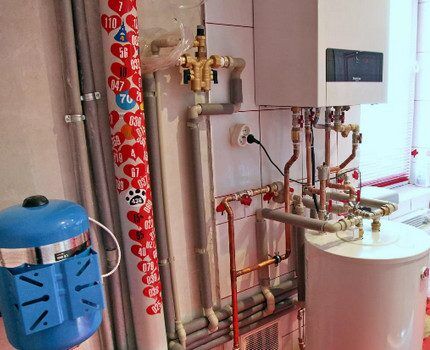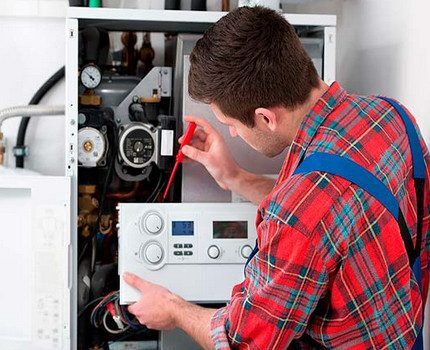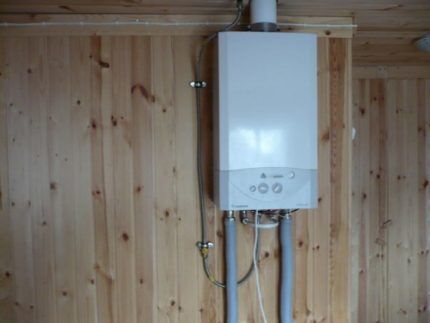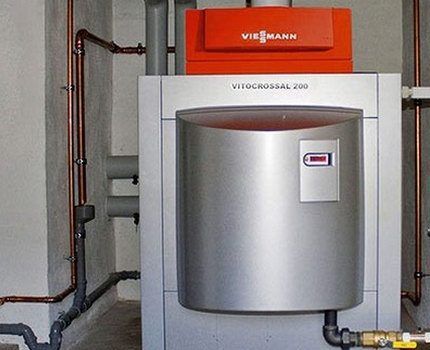Gas boiler using liquefied gas: operating principle, types, how to choose the right one + manufacturer rating
If it is not possible to connect to the central gas pipeline, then some owners of private houses decide to install autonomous gasification. The heart of such a system becomes a gas boiler running on liquefied gas - the unit is connected to a gas holder or propane cylinders.
The boiler installation is capable of heating a room of any size. In order for the boiler to provide residents with the appropriate level of comfort, it is necessary to carefully consider the issue of its choice.
We will tell you how a gas unit works, what types of boilers are on the market, and what are the features of their installation and operation. So that you can decide on a purchase, we have listed the main selection criteria and prepared an overview of popular manufacturers of heating equipment.
The content of the article:
General description and operating principle
Liquefied gas is a natural resource, artificially cooled to a temperature of -160 °C for ease of storage and transportation.
A boiler using this type of fuel is a traditional heat generator in appearance, design and type. It burns gaseous fuel and directs the resulting heat to heat the heat exchanger.

From there, the useful resource is “taken” by the coolant and transports it along the loop communications, thus heating houses and heating domestic water, if this is provided for by the design of the equipment.
Specific features of operation
The first main difference between the unit and analogues operating on traditional main gas is the ability to function efficiently even with reduced fuel pressure. The second is a special nozzle in which the nozzle holes have a reduced diameter, suitable specifically for a propane-butane mixture.

Selected manufacturers traditional gas boilers equip their products with injection systems so that, if necessary, customers can convert the equipment to liquefied fuel.
True, you will additionally have to install a special nozzle, reconfigure the gas valve and replace some parameters in the electronic board of the heat generator. But after all these steps, the boiler will work in a new mode, and customers will be able to effectively heat their homes with liquefied gas.

The uninterrupted operation of the device is guaranteed by the presence of constantly supplied fuel. These can be ordinary gas cylinders, combined into groups of 2 to 15 pieces, or different types of gas tanks.
The connection of supply communications to the boiler is carried out using gas reducer. It controls the supply of fuel and ensures its reasonable consumption - within 1.8-2.0 m3/h.

The main functionality also includes a safety unit, consisting of safety valves, a temperature controller, flame and pressure sensors. A system equipped with these elements is easy to operate and does not create any problems for the owners during use.
Types of propane boilers
There are three types of units on the household equipment market. These are single-circuit, double-circuit and condensing boilers. They perform similar tasks, but differ in design and functionality.
Features of single-circuit devices
A boiler with one circuit is intended only for heating a room and is usually installed where water heating is solved in some alternative way.

The module is equipped with a closed combustion chamber, and during operation the boiler flame is enriched with oxygen coming from the room where the equipment is located. The materials waste during the combustion process are discharged to the street through a vertical chimney specially equipped for this purpose.
Nuances of double-circuit products
Devices equipped with two circuits effectively heat residential premises of any size and provide households with hot water. The coolant is heated by two burners, ignited using an igniter equipped with a built-in system of piezoelectric elements.
When the flame lights up, the temperature sensor is activated. Upon reaching certain indicators, it gives a signal to the automation, and access to the combustion chamber is closed.

Waste materials and acidic impurities leave the room through a chimney or through a ventilation outlet.
How condensing units work
A condensing-type boiler supplies both heating and hot water for domestic purposes to a living space, but does it somewhat differently than a double-circuit boiler. In a condensing device, cold water, once in a heat exchanger, is heated by a burner and hot air.

Then half of the liquid goes into the heating system communications, and the second half goes to the taps for washing, washing and other household needs. After going through a full cycle, the water from the radiator returns to the heat exchanger and the whole procedure is repeated again.
Types of products by location
Equipment operating on liquefied fuel can be floor-mounted or mounted. Each option has specific characteristics that make it attractive and practical under certain conditions.
Having this information in hand, owners can independently determine which device is most suitable for them, and then purchase it in a specialized store.
Option #1: floor equipment
Floor-standing devices are the most widespread. These are high-power units that can provide comfortable heat and hot water not only to standard residential buildings, but also to large-sized country cottages.
The main operating element of the devices is a pressurized gas burner. It has a good degree of efficiency and has high heat dissipation.

The boilers are equipped with a cast iron or steel heat exchanger. The cast iron element is heavy and has a long service life. A steel object is much lighter, but exhibits fragility, sensitivity to mechanical damage and shock, and lasts for a shorter period of time.

Depending on the manufacturer, the device is equipped with a piezo or electronic ignition system. In the first option, the device is started manually by pressing a button.
In the second case, activation occurs automatically, and the boiler does not consume excess fuel during operation, since the system does not have a pilot light with a flame burning continuously.
Detailed information on the selection and installation of floor-standing gas boilers is presented in the articles:
- Floor-standing gas heating boilers: types, how to choose, review of the best brands
- Do-it-yourself installation of a floor-standing gas boiler according to technical installation standards
Option #2: wall mounted devices
Boilers designed for wall mounting are compact in size and have a modern appearance. They take up a minimum amount of space and are suitable for placement in small rooms with complex layouts.

Functionally mounted gas units They are no different from floor-mounted ones, however, they have slightly less power and are not very suitable for use in large, spacious houses. But they use fuel economically, while providing a high level of comfort in the living space.
Advantages and disadvantages of units
Boilers running on liquefied gas are cheaper than appliances using other types of resource.
Among the advantages of the equipment are such parameters as:
- Complete independence from centralized fuel supplies and regular increases in prices for utility services. The autonomy of the system ensures the absence of emergency situations.
- High level of efficiency - on average 92-95% and up to 97% for individual models.
- Quiet burner - for comparison, the burner device of a diesel boiler produces a noise effect of 60-75 dB.
- Ease of maintenance. The equipment does not require labor-intensive and expensive maintenance, replacement of the fuel filter and nozzle, reconfiguration of the burner and cleaning of the heat exchanger.
- Ability to work via main gas — in the future, you won’t have to buy a new boiler, but rather switch the existing one to a centralized supply of blue fuel.
- Duration of operation — service life of floor-mounted ones is up to 25 years, wall-mounted ones – 15-20 years, subject to qualified installation, compliance with operating rules and timely maintenance.
- Safety of liquefied gas devices — the fuel does not ignite even when the container in which it is contained is heated. Combustion occurs only at the moment of mixing the substance and oxygen, and this happens directly in the burner and only in it.
There are completely energy-independent products on sale that allow you to organize a full-fledged heating system in hard-to-reach conditions, for example, in remote forest areas or high in the mountains.
Of the disadvantages of devices, the following positions are the most significant:
- the need for constant high-quality work to connect the boiler to 3-4 propane cylinders using a reducer and ramp;
- It is not advisable to place containers with liquefied gas near the boiler - it is better to place them in nearby rooms equipped with a good ventilation system, or take them outside and install them in a special box;
- care and caution required when connecting the cylinder, since all operations are performed manually and require the use of physical force;
- subsequent conversion of some boiler models to use regular gas is expensive (replacing the burner costs 30-40% of the total price of the boiler);
- installation of the unit and connection to gas supply communications must be done by a licensed specialist with experience.
The balance of pros and cons must be considered in each individual case and, based on the conclusions drawn, a decision must be made regarding the advisability of purchasing this or that type of equipment.
Important selection criteria
When planning to purchase a device, you need to take into account such a parameter as the base power. This indicator is measured in kW and indicated in the documentation supplied with the boiler. The heated area is usually 9-10 times this value. For example, by purchasing a unit with a capacity of 10.5-11.3 kW, it will be possible to fully heat a house measuring about 100 sq.m.

The efficiency of the unit is also very important. The higher this indicator, the more economically the boiler uses fuel resources, while ensuring the most efficient return.In models of the budget line, the coefficient usually fluctuates in the range of 90-94%.
For more advanced premium products it reaches 96-97%, but the cost of such units is an order of magnitude higher than the average price.
Another key item that cannot be ignored is fuel consumption. The data provided by the manufacturer in the accompanying documents is considered conditional.
How much gas gas boilers running on propane actually consume depends on the efficiency and power of the units, the set temperature in the living room, the actual heat loss of the building and other factors.
Only specialized specialists can determine more accurate figures, but even their information will have an error of 10-15%.

If your plans include organizing only a heating system, a single-circuit boiler is suitable for purchase. When you also need to provide hot water, you will have to purchase a condenser or double-circuit gas unit with an open or closed combustion chamber.
For a large residential cottage, it is better to choose a floor-standing device. It has more power and can provide the room with useful heat and the required volume of hot water.
For a medium or small house, or an apartment on the ground, a compact hanging device will be sufficient. When placed, it will not take up much space and will harmoniously fit into any type of interior design.
Rating of popular models and manufacturers
Boiler Siberia, manufactured at the domestic enterprise JSC Rostovgazoapparat, is the best-selling module among all those presented on the gas equipment market today.
It is a non-volatile unit with a highly reliable Eurosit automation system, made in Italy and fully adapted to domestic operating conditions.

The heat exchange tank is boiled automatically and due to this it has increased strength. Double-circuit boilers are equipped with a flow-through copper circuit for efficient heating and subsequent supply of hot water to the system.
The module is controlled at an intuitive level and does not create difficulties even for those users who are not familiar with technology.
The models are presented in the widest range and various sizes, they are safe and silent. The high quality of the products is confirmed by standard certification certificates, and the reasonable cost of the devices makes them doubly attractive in the eyes of buyers.
An Italian company supplies high-quality equipment that is competitive in all respects to the Russian market. Ferroli. The products of this company are distinguished by a stylish, modern design and a convenient control panel that displays the general operating mode of the equipment and temperature indicators.

Among the main features of the equipment is a compact copper heat exchanger, created using technology patented by the company. It consists of 3 communication tubes connected in series into a single complex.
Inside them there are serpentine DHW elements, and the outer part has an anti-corrosion coating made on the basis of an aluminum alloy. The boiler is the smallest and lightest unit on the market.
German corporation Bosch offers convection turbocharged boilers designed for wall mounting. They operate correctly at low gas pressure in the system and provide the room with adequate heat in the required volume.

No less high-quality and practical boilers for operating on liquefied gas are supplied by the industrial group Viessmann (Germany). The product line includes both floor-mounted high-power modules and wall-mounted compact units for small rooms.

All processes are fully automated, and some premium models have the ability to connect SMS notifications or open access to control via the Internet.
In addition to classic ones, the company also produces condensation products.They consume fuel with extreme efficiency and provide heat transfer of 97%. The heat exchange device in them is made of steel, and the presence of a controller allows the user to install an additional thermostat.
Conclusions and useful video on the topic
How to properly organize gasification of a living space using gas cylinders. Connecting boilers, features of increasing system power in the event of an increase in customer energy demand:
Features of the operation of a floor heating boiler operating on liquefied fuel:
Installation of modern. A boiler running on liquefied bottled gas is the optimal way to install a heating system in a house located far from centralized communication networks. The equipment is practical, durable, reliable and copes well with the assigned tasks.
If in the future there is a need to switch to using the main gas resource, the unit will not have to be completely dismantled.
It is enough just to call a specialist, pay for a burner replacement, make some changes to the electronic control unit, reconfigure the valve, and the equipment will begin to fully function in the new mode, without causing any problems or inconvenience to the owners.
Are you looking for an efficient and reliable gas boiler for your home? Or do you have experience using such installations? Please leave comments on the article and share your impressions of using gas equipment. The contact form is located in the lower block.




In our village they first promised main gas, but then they changed their minds about delaying it. It's good that I didn't invest in the boiler while it was being built.In the summer I already installed heating, bought a double-circuit one for liquefied gas. True, they tried to dissuade me - like, take a water heater and a boiler, what if the boiler breaks down and you will be without water and heat. But I still took a wall-mounted dual-circuit one, launched the system in October, everything was fine. Moreover, I installed a boiler with a power reserve; I will also build an extension.
When I get rich, I want to get a tank like a gas holder, I saw it in Italy, many people there have such equipment. So as not to refuel often. So, I am now completely autonomous in terms of heating and hot water.
Liquefied gas cylinders are an extremely dangerous thing. In my opinion, the most dangerous of all options. Neither the same gas boiler from the main line, nor a coal and wood boiler, nor, even more so, an electric boiler pose such a threat to life as these greetings from the last century called “cylinders”. I lived in a rural area for a long time, back in the 90s. There these cylinders were very popular for gas stoves. And regularly the news spread around the village that somewhere a house or hut with such “equipment” had exploded. Either in our settlement or in a neighboring area. It's very scary. If you don’t have mains gas, like the commentator above, don’t skimp on your life - splurge on an electric boiler. Electricity is everywhere these days.
If you're afraid of wolves, don't go into the forest! If only you knew fully how dangerous nuclear fuel is, but it is in demand, and therefore it works. If you follow the operating rules and a little practice, everything will work for a long time and trouble-free!
If used incorrectly, everything is dangerous - the electrics can short out, and the stove can cause fires. Do not use expired cylinders; they have a certificate and year of verification.Check for gas leaks when connecting and you will be happy! And heating with gas is 30 percent more profitable than heating with electricity—we’ve been heating like this for 15 years!